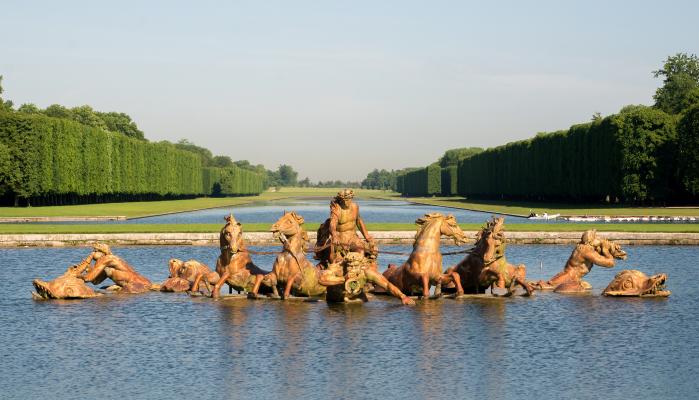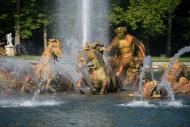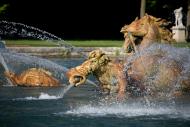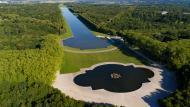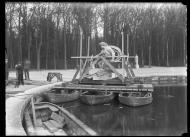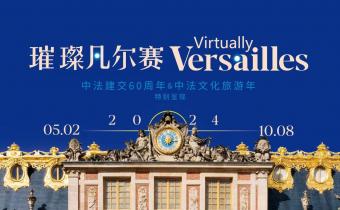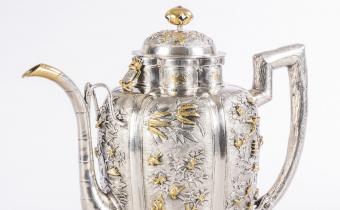An emblematic fountain of Versailles gardens
Located in the middle of the Grande Perspective, at the end of the Royal Way running from the Palace to the Great Canal, Apollo's Fountain is undoubtedly one of the most famous fountains in Versailles gardens. Designed by Jean-Baptiste Tuby between 1668 and 1670 at the height of the reign of Louis XIV and crafted at the Gobelins Manufactory, the fountain is adorned with the set of sculptures making up Apollo’s Chariot. According to the allegorical and mythological meaning of the gardens as Louis XIV wanted them construed, this fountain represents the rising sun. This monumental lead sculpture weighs some 30 tonnes and comprises 13 statues. Apollo is in the middle, accompanied by an amorino on his chariot, drawn by four horses. Tritons are positioned at the four points of the compass, while dolphins are perched at the edges in between them. Each of the figures lunges forth in a unique pose and contributes to the dynamic feel of the scene as a whole.
currently in a state of concern
The last major restoration campaign on the fountain, which saw the set of sculptures disassembled and restored in a workshop, took place just over a hundred years ago between 1923 and 1927. Remedial work has been undertaken as and when needed, not least on the horses’ heads which were buckling, in 1955 and again in 1981. Despite regular maintenance, this set of sculptures, on which the water feature aspect takes its toll, is now in serious disarray. Structural warping linked to corrosion of the internal plumbing, significant deterioration of the lead and severe erosion of the surface coating can be seen. Its condition warrants urgent remedial work.
In addition, in their current state the water jet patterns are out of kilter and very far from their historic initial design.
far-reaching restoration work
This new campaign will begin in December 2022 with the complete disassembly of the set of sculptures for transfer to a workshop, where the 13 lead sculptures will be fully restored and re-gilded. At the same time, the stone base of the set of sculptures will be consolidated in situ, as will the waterworks, the restoration of which will be carried out by the Palace fountain technicians. This work will conclude with the re-installation of the restored set of sculptures and the crafting of new nozzles by the fountain technicians to restore the original water jet patterns. The illumination of the pool and statuary will also be completely redesigned.
This work will call for the input of an array of expertise: decorative foundry work, metalwork, gilding, fountain work and even stonework and stonecutting.
Contractor
Jacques Moulin, Head Architect of Historical Monuments, 2BDM agency
Contracting body
Department of Heritage and Gardens at the Palace of Versailles.
Companies
- Lead sculptures:
Sculptures: FONDERIE DE COUBERTIN
Gilding: ATELIERS GOHARD
- Stonework and stonecutting:
ENTREPRISE LÉON GROSSE / ÉTABLISSEMENT CHAPELLE
CMA CGM Group, a global player in maritime, land-based and airborne logistics solutions, is funding the restoration of the Apollo’s Chariot Fountain and the greenery around it.
The work of the Palace of Versailles fountain technicians
The gardens’ waterworks are a gravity-driven water system dating back to the late 17th century. Three different sources feed into Apollo’s Fountain: the Latone basin (for the water jet in the middle of the fountain), the Lizard basins (for the water jets on the sides) and the Jambettes basins (for the water jet patterns of the tritons, dolphins and horses). The water jet patterns spouting from the set of sculptures form a well-rounded symmetrical composition, contributing to the majestic aesthetics of the fountain. This finery of water forms a showcase that frames the set of sculptures, which is intended to be viewed from the bottom of the Allée Royale.
The pipes that supply the water jets are made of cast iron (17th and 19th century) and lead. Regular restoration work has been undertaken since the 18th century, and these water features undergo regular maintenance by the Palace of Versailles fountain technicians. In spite of this work, these pipes are currently showing signs of incidental deterioration.
While the pipework is mostly old, the same can be said of only one of the 27 fittings used to form jets (also referred to as nozzles) on this fountain. Moreover, it seems that the jets' angles of projection have been altered substantially over time by the buckling or reworking of the sculptures. For example, some water jets are aimed directly at the bottom of the pool, without forming an arc, thus distorting the entire pattern compared to the way it was originally intended.
Claude Denis' 1692 description of the water jet patterns tells us which three types of nozzle were used for this set of sculptures, as identified thanks to recent research:
- Horses: a nozzle with four holes and a cross to form the splashing effect of a galloping horse.
- Tritons and dolphins: a nozzle with 13 holes to create a neat water jet pattern forming a clear-cut arc.
- Amorino and side water columns: a nozzle with 17 holes: eight large, eight small and one in the middle, forming a straight vertical water jet pattern at the base and a sprinkler effect at the top.
The Palace of Versailles fountain technicians are now going to undertake work to restore the old pipework and make all the connections between these pipes and the statuary. They will then restore and, where necessary, replace the nozzles to restore the original water jet pattern to the water. Thus they will contribute to the harmonious aesthetics and clear-cut nature of the fountain and the whole scene.
These operations follow on from the restoration work previously undertaken on the Latone fountain and all the daily maintenance and restoration work that the fountain workers carry out in the gardens. It will mean that the magic of water can always shine through at Versailles, just as it did at the time of Louis XIV.
The restoration of Apollo's Fountain will allow one of the most famous fountains in the Versailles Palace gardens to re-emerge in all its former glory. Through this project, CMA CGM Group wanted to enhance one of the major pieces of this emblematic French heritage site. This major heritage operation will restore the splendour of the Grande Perspective, such as Louis XIV envisaged it.

